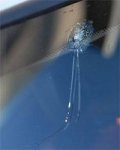 Back in the early days of automobiles, before seatbelts and airbags were part of the package, one of the gravest dangers was injury from shards of shattered windshield glass. We can thank French artist and chemist Édouard Bénédictus for chancing upon the invention of laminated glass, also known as safety glass.
Back in the early days of automobiles, before seatbelts and airbags were part of the package, one of the gravest dangers was injury from shards of shattered windshield glass. We can thank French artist and chemist Édouard Bénédictus for chancing upon the invention of laminated glass, also known as safety glass. While in his lab, a glass flask dropped and broke but didn’t shatter, Bénédictus realized that the interior was coated with plastic cellulose nitrate that held the now-harmless broken pieces together. He applied for a patent in 1909 with a vision of increasing the safety of cars, but manufacturers rejected the idea to keep costs down.
However, the glass became standard for gas mask lenses in World War I. With its success on the battle field, the automobile industry finally ceded and by the 1930s most cars were equipped with glass that didn’t splinter into jagged pieces upon impact.
